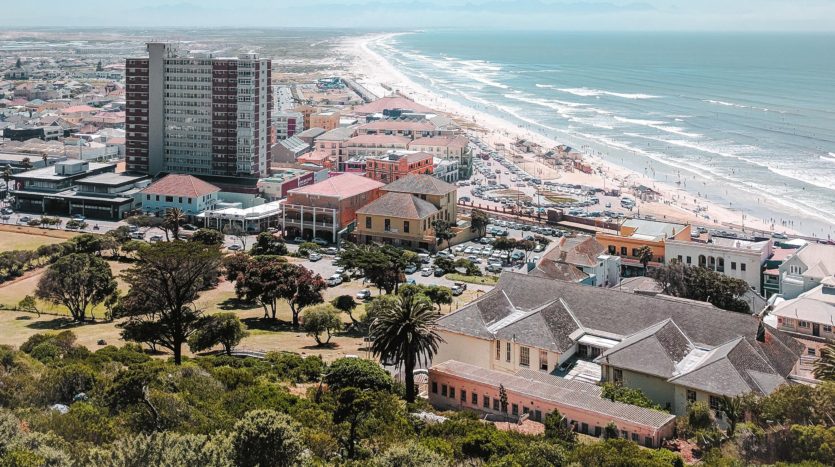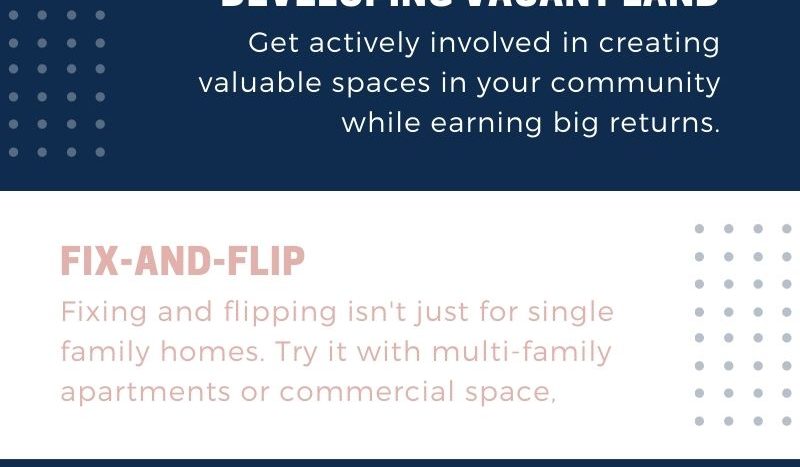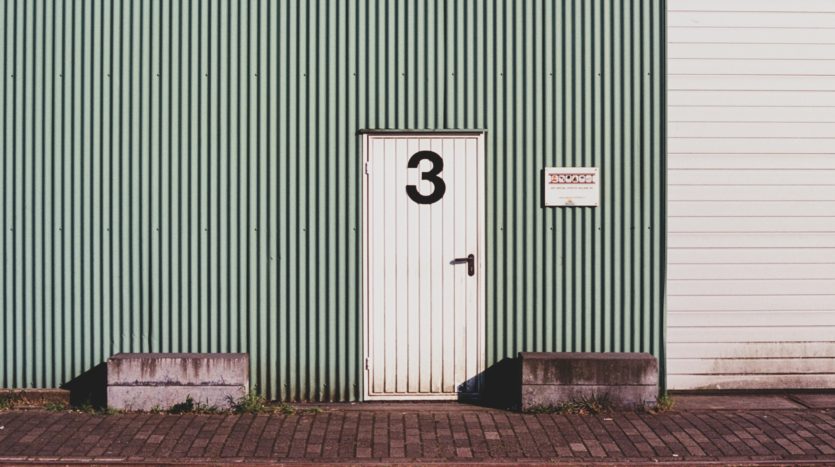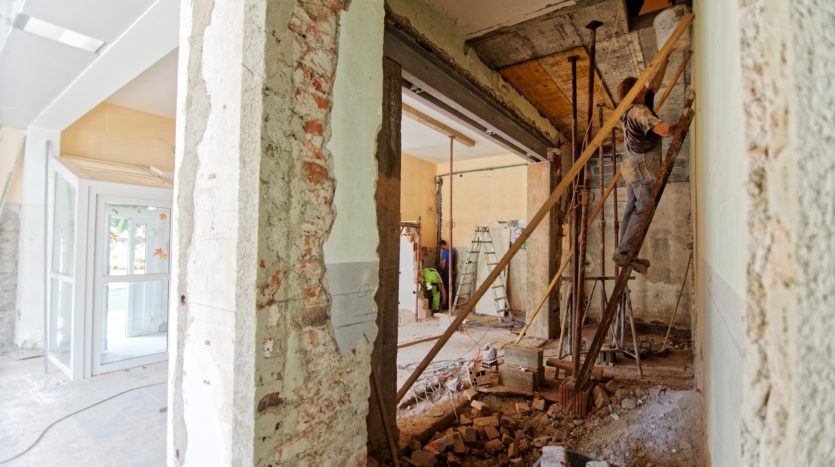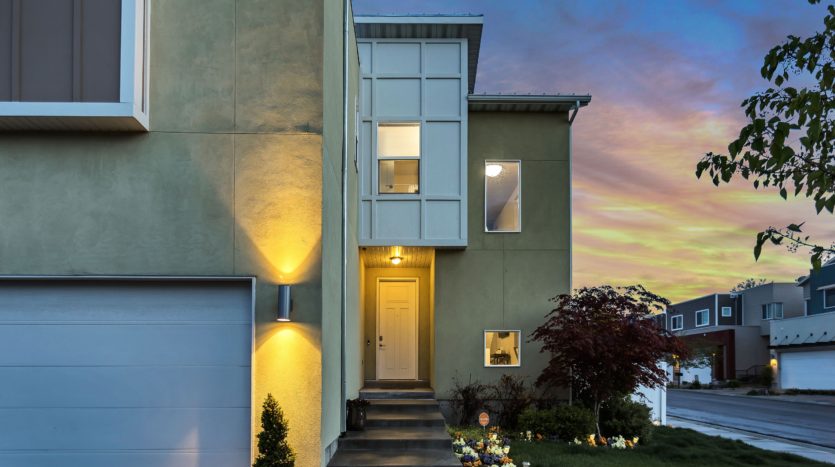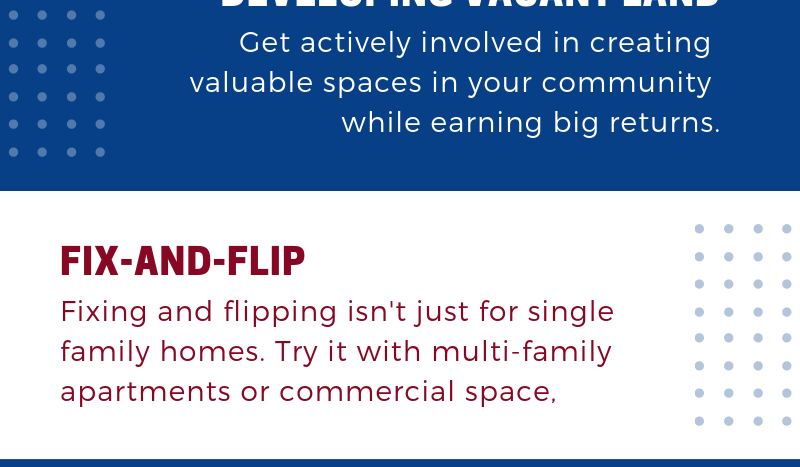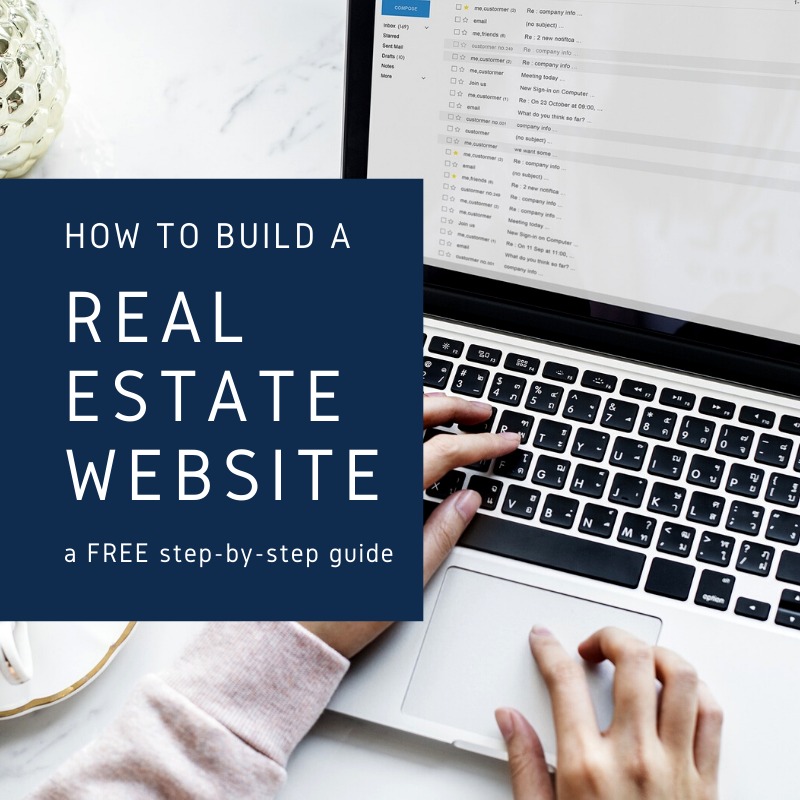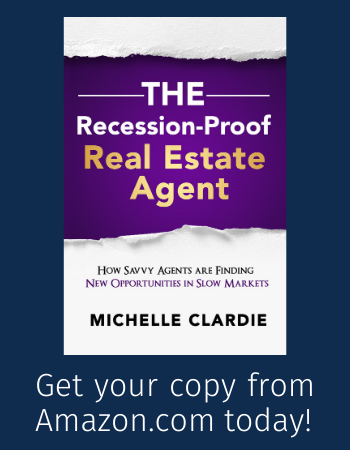Real estate has always been a great investment. And it’s a whole lot more versatile than you might think. In fact, we’ve come up with 18 different ways to invest in real estate.
Maybe you’re looking to invest yourself. Or maybe you’re looking to provide options to your real estate clients. Either way, we have ideas for ways to invest in real estate that can work with any skill level, experience, and budget.
Note: this article was originally published in 2019. Here is the new, improved version.
18 Different Ways to Invest in Real Estate
We’re going to organize this list of ways to invest in real estate into four categories:
- Buying Rental Properties
- Flipping Properties
- Investing Without Actually Buying Property
- Renting Out Your Existing Space
No preamble…let’s get right to it!
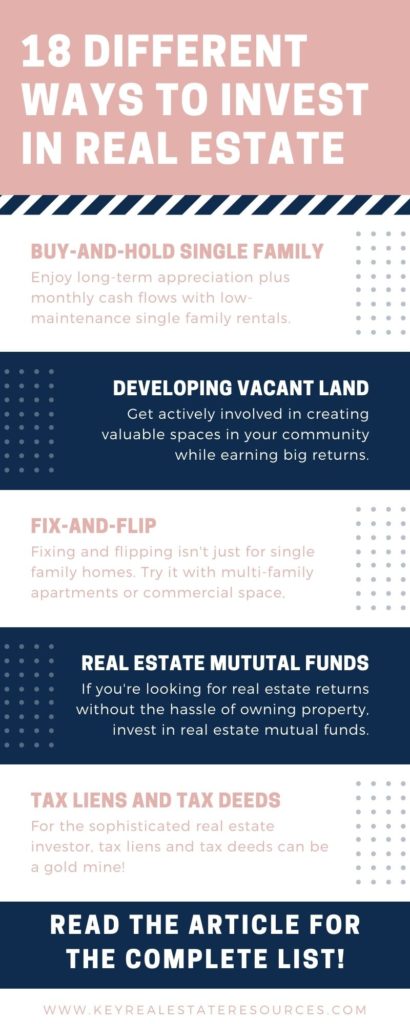
Buying Rental Properties
Buying a property to rent out is the classic real estate investment model. And it’s my personal favorite.
The main reason I love buying and owning rental properties is that these properties make money in multiple ways.
First, real estate appreciates over time. Yes, the market is cyclical; sometimes it will be up and sometimes it will be down. But over the long term, real estate appreciates, and your net worth grows with it.
Secondly, rental properties provide cash flows. Not only do your tenants pay down your mortgage debt for you, but their rent also covers your insurance, property taxes, and maintenance plus puts money in your pocket every month!
And finally, there are the tax benefits. The money you invest in maintaining your rental properties is tax-deductible, so you’re saving money on your income taxes thanks to your rental properties.
We have six different ways to invest in real estate rentals.
1. Buy Single-Family Homes
Buying a single-family home is one of the best ways to invest in real estate as a beginner.
You buy a home, rent it out to long-term tenants, and collect your rent checks every month. Nothing to it!
As with any rental investment, the key to success is to buy right and find quality tenants.
Only buy a property you’re sure will be cash flow positive from Month One. You should be confident that the rent you charge will cover all your expenses and still create income every month. Then take the time to carefully screen potential renters. You’re looking for reliable, responsible people who will want to be in the house for at least a couple of years. People who will pay on time, respect the property, and be a joy to work with.
The cost to start investing
Generally, you need to be able to put 20% down on an income property. So $80,000 on a $400,000 house, for example.
But there are ways around this. If you buy a property as your primary residence, you can get an FHA loan with only 3.5% down, for example. So just $14,000 on a $400,000 house (assuming you qualify for the loan). That’s how I started my investment portfolio. Every time I moved (every 3-5 years), I would buy a new house as my primary residence, then that property would become a rental property the next time I moved. I’ve been able to acquire multiple properties without ever having to put the full 20% down.
Don’t forget, you’ll also have closing costs. Those typically run between 2% and 5% of the purchase price, depending on your local market.
Skills required
You really don’t need any special skills to rent out single-family homes. You just need an understanding of how to buy and manage rentals.
Hold: How to Find, Buy, and Rent Houses for Wealth by Steve Chader is the best book I’ve read on the subject. I recommend this book to anyone looking to start investing in single-family homes.
What Every Real Estate Investor Needs to Know About Cash Flow…and 36 Other Key Financial Measures by Frank Gallinelli and The Book on Rental Property Investing: How to Create Wealth and Passive Income Through Smart Buy & Hold Real Estate Investing by Brandon Turner are also useful resources.
And if you have no interest in managing your rentals, simply hire a property manager to take care of it for you!
2. Buy Vacation Rentals
Let’s take single-family home rentals a step further…let’s talk about vacation rentals.
Unlike single-family rentals, vacation rentals are tailored for short-term use, often rented for only a few nights at a time. Think Airbnb.
Your vacation rental needs to be located in a highly traveled area like a vacation destination or the heart of a popular city. And it needs to be furnished (down to the linens, dishes, and toiletries).
Vacation rentals require more day-to-day management than most other ways to invest in real estate because of the constant renter turnover. You (or your property manager) will constantly be making reservations, arranging check-ins/-outs, scheduling cleaning, and restocking the unit.
Be warned: your vacation rental will take a lot of wear and tear. Vacationers are generally hard on the unit and the furnishings. So you’ll want to budget for repair and replacement from the beginning.
The payoff for your investment is that the nightly rate on vacation rentals far exceeds the nightly rate on long-term rentals. You won’t have the unit rented every night, but the rate should more than make up for the vacancy. And you get the added benefit of having access to a vacation home for yourself (or friends and family) while the unit is vacant.
The cost to start investing
You’ll need to cover the down payment and closing costs plus the cost of completely furnishing the unit. So it will likely be well into the tens of thousands of dollars.
Skills required
If you’re going to manage the property yourself, you’ll need to be well-organized and detail-oriented. And you’ll need an ongoing marketing plan. You’ll also need to be skilled in customer service.
Myths, Management & Mastery of Vacation Rentals by Jeramie Worley is like a crash course in vacation rental investing.
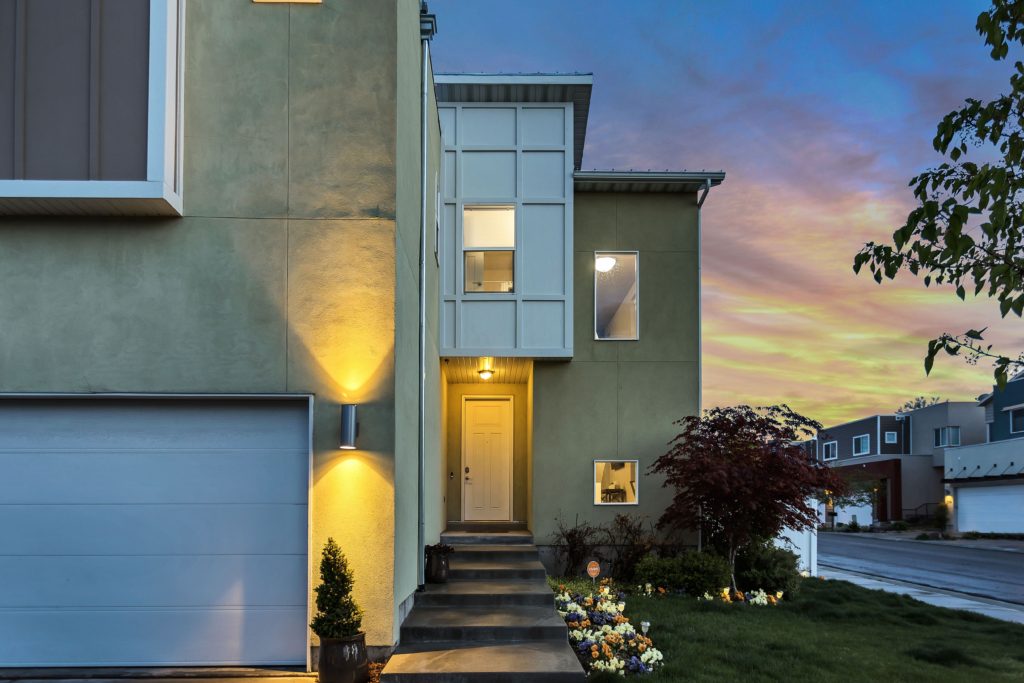
3. Buy Multi-family Residential
You don’t have to grow your investment portfolio one unit at a time. You can acquire multiple units in one transaction by buying multi-family residential. Anything from a duplex to a small apartment building to a large apartment community.
The money-making model is the same as with single-family homes, but there are a few key differences to point out:
- With a multi-family building, you have the option to live in one unit and rent out the others. Your living expenses could effectively be covered by your other tenants. And you can keep an eye on everything if you live on-site.
- Your initial investment will likely be higher since multi-family units typically cost more than similar-quality single-family homes.
- Multi-family typically produces higher profit margins than single-family.
- Your portfolio will be automatically diversified; one tenant moving out isn’t a huge deal when you have other occupied units to pick up the slack.
- More units mean more work. Even if you plan to manage the property yourself (in which case, make sure you invest in some inexpensive, but effective, property management software), factor the costs of property management into your projections so you’ll have the option to get a property manager if you find you need one.
One more thing: low-rent units are known for creating more headaches than higher-rent units. If you’re deciding between a middle-of-the-road single-family home and a dodgy multi-family building in a sketchy neighborhood, your life will probably be easier with the single-family home.
The cost to start investing
Generally speaking, lenders want you to put 20% down on a duplex and 25-30% on properties with more than 2 units. That would be $150,000 on a $500,000 property. Don’t forget about closing costs and money to make the units ready for rent.
On the plus side, you may be able to buy a building with leases in place, so you’ll have the assurance of income from Day One.
Skills required
If you’re managing the property yourself, you’ll need to be organized, good with numbers, and good with people. Sales skills are also helpful if you have regular turnover. And home maintenance know-how could save you a fortune in plumbers and electricians.
The best resource I’ve seen for investing in small apartments is Crushing It in Apartments and Commercial Real Estate: How a Small Investor Can Make It Big by Brian Murray.
Not only will this book help you with multi-family, but it can also help you with the next item on our list of ways to invest in real estate…
4. Buy Commercial
How would you like to own office or retail space? Or maybe an entire shopping center?!
This is a step most real estate investors never take. Probably because it’s less familiar than residential real estate.
But there’s lots of money to be made in commercial real estate. And it’s not all that different from residential.
Instead of renting to individuals, you’ll likely be renting to companies. And you’ll enjoy longer leases, so you won’t have to deal with as much turnover. Leases are usually 2-5 years, but up to 30 years for box stores and anchors.
The downside is that the upfront expense can be substantial. And it is more difficult to find a commercial tenant than a residential tenant. Also, commercial real estate is in lower demand since the popularization of online shopping and the work-from-home revolution.
The cost to start investing
Most lenders will require 25-30% down on commercial investment properties. Plus closing and make-ready costs. So you’re probably looking at a significant investment unless you’re willing to try some creative financing.
Skills required
Owning commercial property honestly doesn’t take much skill. It generally requires less ongoing work than residential (you won’t get a call in the middle of the night about the hot water heater!). And because of the long leases, commercial investment income is relatively passive once you get a tenant in. Of course the more units you have, the more work it will take to manage the property.
As mentioned, Crushing It in Apartments and Commercial Real Estate: How a Small Investor Can Make It Big by Brian Murray is a great place to get started!

5. Buy Industrial
There are several different ways to invest in real estate in the industrial category:
- Warehouses
- Industrial office space
- Manufacturing space
- Self-Storage facilities
- Auto repair space
The process is the exact same as investing in commercial space. But industrial properties may be more affordable than commercial because they lack some of the polish. They’re not in the most expensive parts of town, and they don’t require the same level of maintenance (like landscaping and painting) that commercial spaces do.
Industrial is one of the least glamorous ways to invest in real estate. But that doesn’t mean it can’t be lucrative.
Quick warning: some industrial spaces are highly specialized, which can make it difficult to find new tenants if your current tenants vacate.
The cost to start investing
You’ll still need to find the standard 25-30% down payment. Plus closing costs. If at all possible, buy a space with a lease already in place so you don’t have to stress about finding a tenant.
Skills required
Minimal. Like commercial spaces, industrial spaces typically have long leases and are fairly low maintenance.
6. Buy Vacant Land
You can do a lot with vacant land!
You can buy land on the outskirts of a spreading metro area, and sell your land to a developer in a few years.
Or you can buy land to rent out. Farmers and utility companies like to lease land.
You could erect billboards and simply sell advertising space.
Or you could develop the land yourself. There are so many possibilities!
The cost to start investing
Depending on the area, you can pick up land dirt cheap. The down payment may be more like 30-50% (since lenders may not have the reassurance of rental income), but with the relatively low cost, a higher down payment is manageable.
Skills required
Speaking of flipping, we’re ready to move onto a whole new category of ways to invest in real estate!
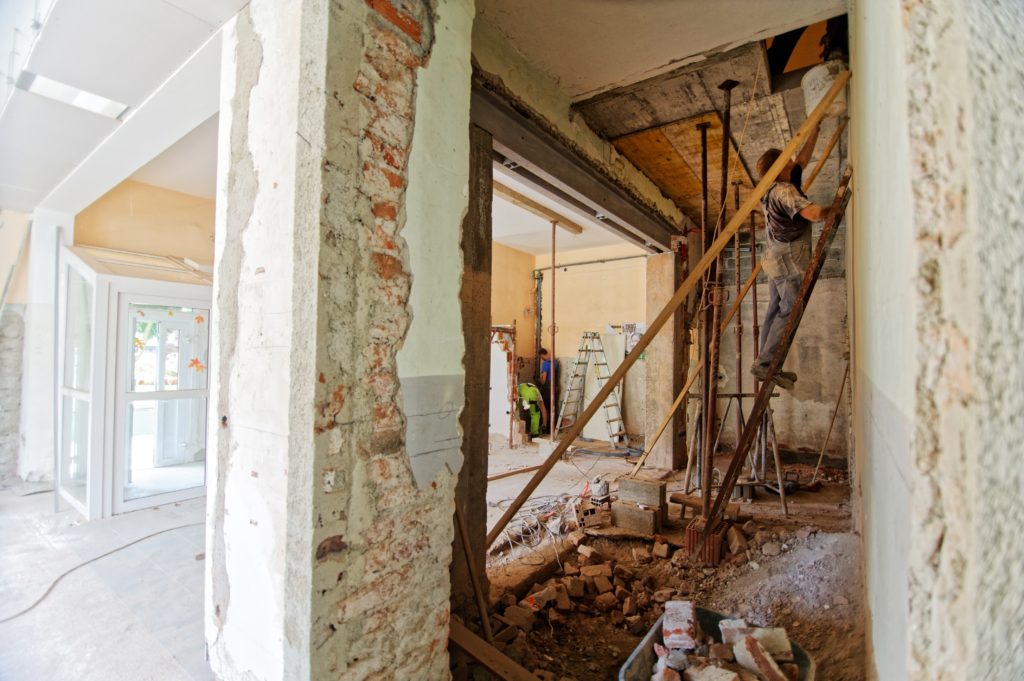
Flipping Properties
To this point, we’ve covered six ways to invest in real estate. All via the buy-and-hold model. It’s time now to move on to the fix-and-flip model.
7. Fix and flip any property type
When you think of flipping, you probably think of single-family homes, right? That’s what we always see on HGTV anyway. Investors buy a fixer-upper, renovate it, and resell it a month or two later. Quick money!
But you don’t have to limit yourself to homes. You can fix and flip any of the property types we’ve discussed so far. Although it should be noted that you’ll have more luck flipping residential and commercial spaces than you would with industrial.
I will warn you: flipping isn’t as easy as it looks on TV.
While TV flippers have a happy resolution by the end of the show, flippers in reality have to deal with months of problem after problem. And potentially months of worry as the newly renovated property sits on the market. In the real world, losing money on a deal isn’t uncommon.
Fixing and flipping is riskier than the buy-and-hold model. But it can provide quick returns to investors who know what they’re doing.
Generally speaking, you should only consider flipping in a hot market. When real estate prices are climbing so fast that you can be sure the property will be worth more three months from now, even without renovations, that’s the time to flip.
By the way, some states, like California, have authorized the building of ADUs (accessory dwelling units) on single-family lots. If you’re into construction, you could add value quickly by building an ADU and effectively turning the single-family lot into a small multi-family development.
The cost to start investing
Not only do you need the 20-30% down payment for the investment property plus closing costs, but you’ll need a whole lot of liquid funds for renovations. The renovations alone can easily exceed $100,000. Don’t forget to factor in closing costs on both sides of the deal (the many fees for buying plus the big realtor commission when selling) when projecting profits.
In fact, if you’re considering flipping, and you don’t already have your real estate license, I strongly recommend getting your license and learning the trade. It will pay off big over multiple deals! And getting your real estate license doesn’t have to be expensive. For example, a new online real estate school, AceableAgent, offers a complete state-required real estate education for under $500. They currently offer courses for Texas and New York, but they’re growing into multiple states. For all other states, I recommend Real Estate Express. They’re one of the most reputable real estate schools in the US, and they offer engaging curriculum, affordable rates, and comparatively high exam pass rates.
Skills required
Flipping requires some serious skill:
- Financial projections
- General contractor skills (or the skills and money to manage a contractor)
- Real estate sales (if you plan to buy, list, and sell on your own)
Flipping is the first item on our list of ways to invest in real estate that really isn’t for just anyone. Flipping is for active investors who genuinely love the renovation process.
I highly recommend FLIP: How to Find, Fix, and Sell Houses for Profit by Rick Villani for anyone who wants to learn more about flipping.
8. Wholesaling
Wholesaling is a very specific type of flipping.
Rather than buying the property, then selling to a new buyer, wholesalers sell a property before they even officially buy it. Instead of flipping the physical real estate, they flip the purchase contract.
Basically, you find a great deal, get it under contract, then sell your contract to another investor for more than you originally agreed to pay. And you pocket the difference.
This is quick money (even quicker than fix-and-flips), plus you never have to get your hands dirty. You don’t even have to ever actually own the property!
Sound too good to be true?
You’re right to be skeptical. There are a few downsides to wholesaling:
- Great deals don’t come along every day. You’ll invest a lot of time in finding deals to wholesale.
- If your buyer bails, you’re left on the hook for the property. This means buying the property yourself or forfeiting your earnest money deposit.
- Profit margins aren’t terribly high. Although they don’t really need to be since the deals are quick and (hopefully!) easy to facilitate.
Wholesaling is largely about relationships. You need an “in” with potential sellers and with investors to buy. And you need to trust that your sellers and buyers will close the deal as expected.
The cost to start investing
The cost to invest in getting a property under contract is simply the earnest money deposit. This varies by market. It could be a simple $500-$1,000 dollars in a slow market, or it could be up to 2% of the purchase price in a hot market.
Skills required
You need to know the market like the back of your hand so you can spot a good deal the instant you see it. And you need top-notch networking and relationship-building skills.
If you want to learn more about ways to invest in real estate through wholesaling, check out If You Can’t Wholesale After This: I’ve Got Nothing For You… by Todd M. Fleming.

Investing Without Actually Buying a Property
We just looked at wholesaling, which (when done right) doesn’t require you to actually buy the property.
Wholesaling isn’t the only way to invest without buying. In fact, we have seven different ways you can invest in real estate without the hassle of actually buying a property yourself.
9. Real Estate Investment Groups and Crowdfunding
If you don’t have the money to buy a property of your own (or the desire to manage your own properties!), but you still want a piece of the real estate investment action, consider real estate investment groups or crowdfunding. Both allow you to pool your money with other investors to buy a piece of a bigger deal than you’d be able to afford on your own.
Traditional real estate investment groups were small groups where everyone had a part to play in the deal: one member may have been the real estate agent, one a lawyer, one a property manager, one a developer, etc. These specialized groups would buy and manage a deal together.
These traditional groups still exist, but crowdfunding has become the more popular way to pool your money with other investors. Crowdfunding typically involves a lot more investors (potentially thousands on a big deal). And these investors don’t take any active part in the deal. You simply buy-in through a crowdfunding platform, then sit back and collect your returns.
There are lots of crowdfunding platforms, and that landscape is always changing. Check The Real Estate Crowdfunding Review for the most current information on how these platforms are performing.
The cost to start investing
You can buy into some deals for as little as $1,000, though $5,000 – $10,000 is more common.
Skills required
There really isn’t any skill involved in investing through groups and crowdfunding. The more important thing is that you do your research to find a group or a platform you trust enough to use.
10. REITs
REITs (Real Estate Investment Trusts) are corporations that invest in real estate. You can invest in a REIT to own a bit of a shopping mall or a high-rise. It’s somewhat like crowdfunding, but much more structured and regulated. The SEC is all over REITs.
The strength of REITs is in their dividends. REITs are required by law to maintain dividend payout ratios of at least 90%. You can accept your dividends as cash flow or reinvest the dividends to grow your investment faster.
Over the long term, REITs enjoy a strong performance with solid returns (just like real estate in general). Over the short term, however, REITs can be volatile. If you plan to invest in REITs, make sure you’re fine with your money being tied up long-term. In fact, you may want to consider investing some of your retirement money in REITs.
The cost to start investing
You can generally invest for as little as $500 – $1,000.
Skills required
You don’t need any special skill to find success in REITs. But you do need to do your homework to find and analyze REITs so you can choose your REITs wisely. To learn all about REITs, check out
The Complete Guide to Investing in REITs – Real Estate Investment Trusts: How to Earn High Rates of Returns Safely by Mark Gordon.
11. Real Estate Mutual Funds
Let’s say you want to invest in REITs, but you’re just not sure how to pick one. Enter Real Estate Mutual Funds.
Real estate mutual funds are traded on the stock exchange. Instead of buying a share of physical property, you’re buying a share of the fund. And the share of the fund is made up of multiple real estate investments hand-picked by the fund manager. These investments typically include REITs and real estate-related stocks.
The great thing about mutual funds is that they provide some instant diversification. Instead of putting all your eggs in a single basket, buying a share of a mutual fund automatically puts your eggs in multiple baskets. If one stock tanks, hopefully the fund as a whole will be buoyed by the other stocks in the fund.
Just know that all the investments in your mutual fund will be real estate related. So if the real estate market as a whole is declining, your mutual fund value will likely decline as well. But when the real estate market is booming, your funds should perform exceptionally well.
The cost to start investing
You can generally invest for as little as $500.
Skills required
No skill necessary, but as with any financial instrument investment, you need to spend time learning about the instrument and researching the individual offerings.
If you’re interested in learning more about financial instruments like mutual funds, The Little Book of Common Sense Investing by John C. Bogle is a great place to build your foundation.
12. Real Estate ETFs
Real estate ETFs (Exchange-Traded Funds) are very similar to real estate mutual funds. There are just a few key differences:
- ETFs trade on the stock market all day long, while mutual funds only trade at the end of the day for the net asset value (NAV) price.
- ETFs generally follow an index, so they aren’t hand-picked by an active manager like mutual funds are. This means ETFs have lower expenses than mutual funds.
- ETFs don’t have an investment minimum.
If you’re looking for a low-expense, easily-liquid way to invest in real estate, ETFs may be the vehicle for you.
The cost to start investing
You can buy a share of a real estate ETF for under $100.
Skills required
None. Just do your homework to decide if ETFs are right for you, and (if so) which ETFs you should invest in.
13. Real Estate Notes
Financial institutions aren’t the only players in the mortgage lending game. Individuals offer mortgage loans all the time. They do this by investing in real estate notes.
Basically, you act as the bank. You lend buyers the money they need to buy their home, then you collect the payment with interest every month. You often see this when home sellers want to sell to a less-than-perfectly-qualified buyer. Maybe the buyer can’t secure funding due to poor credit or no down payment. The seller can carry the note to give the buyer a chance at homeownership.
The property is the collateral for the loan. So if your buyer defaults on the loan, you own the property. At that point, you can either sell it, rent it out, move in yourself, or repeat the process with a new buyer.
There’s also a secondary market for buying and selling existing real estate notes if you don’t want to originate your own.
The cost to start investing
If you carry the note on a property you already own free-and-clear, there’s no significant upfront investment. But if you don’t already own the home, you’re talking about funding the full loan. So the entire purchase price minus whatever down payment you agree to.
Skills required
Are you a good judge of character? That’ll be helpful when deciding who to take a chance on. Remember, you’re typically working with buyers the banks refuse to work with. So there’s a fair amount of risk involved. Make sure you’re charging enough in interest to make the venture worth your while.
You should also educate yourself on the ins and outs of real estate financing before jumping in as there are lots of complexities you should be aware of upfront.
Note Investing Made Easier: How To Buy And Profit From Distressed Mortgages by Martin Saenz is a good place to start your education.
14. Hard Money Loans
If you have a higher tolerance for risk, hard money loans might be a good fit for you.
They’re similar to real estate notes (in that you’re acting like the bank), but hard money loans are short-term. In this case, you’re not going to carry the note on a 15 or 30-year mortgage; you’re going to require payment in full within the next 6-24 months.
Hard money loans might be used to fund a flip. Maybe you have a flipper with a cash flow problem; the market’s prime for flipping, but the flipper doesn’t have the cash to finance the renovation, and doesn’t qualify for a traditional bank loan. You could issue a hard money loan to the flipper for the cost of the renovation at a whopping 10-15% interest rate. When the property sells, the flipper makes a tidy profit, and you earn exceptional returns.
Obviously, there are lots of ways this can go wrong. If the flipper fails spectacularly, the property will likely revert to the bank. You, as the hard money lender, have few reassurances of repayment.
The cost to start investing
It really depends on how much your borrower needs. These loans generally fall in the broad $10,000 to $200,000 range.
Skills required
Is risk tolerance a skill? Cause that’s what you’ll need to play in the hard money loans game. You also need to be a good judge of character and have the networking and relationship-building skills needed to attract deals.
Private Money Lending Learn How to Consistently Generate a Passive Income Stream by Gustavo Gomez isn’t about real estate specifically, but it’s a solid overview of hard money lending in any industry. It’s worth a read if you’re considering hard money lending.
15. Tax Liens and Tax Deeds
The final entry in our section on ways to invest in real estate without actually buying property is investing in tax liens and deeds.
If a property owner fails to pay their property taxes, investors can profit from the default.
Whether you will invest in liens or deeds depends on your state. Some states are tax lien states, some are tax deed states, and some are complicated hybrids.
What’s the difference?
With tax liens: investors buy a lien on the property at a predetermined interest rate. You’re not buying the property; you’re only buying a lien against the property. At tax lien auctions, investors typically aren’t bidding up the value of the lien. The value is simply the amount of property taxes due. Instead, investors bid to see who will offer the lowest interest rate to the property owner for the lien.
With tax deeds: investors are bidding to pay the defaulted taxes and buy the property. So bidding starts at the amount of past-due taxes and investors bid up the purchase price from there. The winning bidder pays the bid amount immediately and takes possession of the property.
With tax deeds, you never know what kind of condition the property will be in. It’s risky, but that’s what makes it so lucrative.
The cost to start investing
Past-due taxes run anywhere from a few hundred to a few thousand dollars. Keep in mind, liens and deeds are both typically offered in an auction setting, so you will be competing with other investors.
For tax deeds, you’ll also want to have enough cash on hand to cover all necessary renovations and repairs.
Skills required
Tax liens don’t require much skill, they just require knowledge of how the system works. Tax Lien Investing Secrets by Joanne Musa (aka the Tax Lien Lady) will teach you how the system works. Then you just need to learn the ins and outs of your local market.
There is a fair bit of skill involved in analyzing properties, determining your top dollar, and sticking to it in the auction environment. Then there’s rehabbing the property. Then whatever comes next: flipping, long-term renting, vacation rental. The tax deed auction is just the beginning.
To learn more about tax deed investing, read Zero Risk Real Estate: Creating Wealth Through Tax Liens and Tax Deeds by Chip Cummings. I hate the title because no investment is “zero risk”, but I’m overlooking that because of the actionable advice in the book.

Renting Out Your Existing Space
What if you want to invest in real estate, but you’re flat broke?
Yes, even if you’re broke, you can still make money in real estate. Simply rent out your existing space. Even if you don’t own your house, you may be able to sublet areas to make some purely passive income.
Here are three ways to invest in real estate with no time, money, or skill!
16. Rent Out a Room
Do you have a spare room? Rent it out!
You can do short-term vacation rentals via Airbnb if you’re in a highly-traveled area. Assuming you’re comfortable having strangers in your space, that is.
Or you can rent out your room long-term. Like getting a roommate.
College kids, for example, are always looking for inexpensive housing. My friend, Crystal, rented out two bedrooms to college girls to cover her mortgage payment in Seattle for years!
The cost to start investing
Maybe furnishings? Could be done for $0!
Skills required
It helps if you’re a good judge of character. You also need to be able to be comfortable having other people in your space.
17. Rent Out Parking
In some cities, you can charge $100/month just for a space to park. Seriously.
If you have a parking space you’re not using, consider renting it out. Apps like Parklee make it easy.
The cost to start investing
$0
Skills required
None!
18. Rent Out Storage
People need storage space! If you don’t have the funds to invest in a self-storage facility, how about renting out your existing storage spaces directly?
Stow It is the perfect platform for listing your storage space for rent.
The cost to start investing
$0
Skills required
None!
Recap
It’s been a long post! How about a refreshing recap of ways to invest in real estate before you go?
Buying Rental Properties
- Single-Family Homes
- Vacation Rentals
- Multi-family Residential
- Commercial
- Industrial
- Vacant Land
Flipping Properties
- Fix and flip any property type
- Wholesaling
Investing Without Actually Buying a Property
- Real Estate Investment Groups and Crowdfunding
- REITs
- Mutual Funds
- ETFs
- Real Estate Notes
- Hard Money Loans
- Tax Liens and Tax Deeds
Renting Out Your Existing Space
- A Room
- Parking
- Storage
What Did We Miss?
Do you have a method of investing that isn’t included in our 18 ways to invest in real estate? Let us know in the comments!
Get Your Complete Recession-Proof Guide!
If you’re serious about growing your real estate business during a slow market, check out The Recession-Proof Real Estate Agent. This book offers a complete step-by-step guide to recession-proofing your real estate business.

